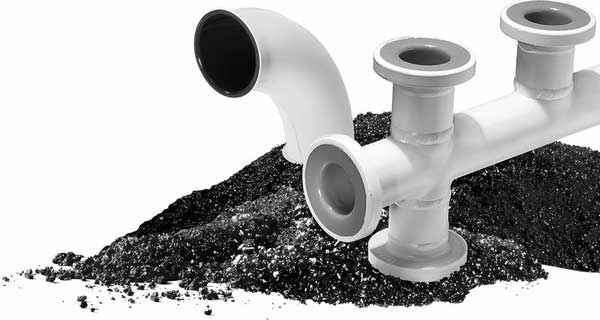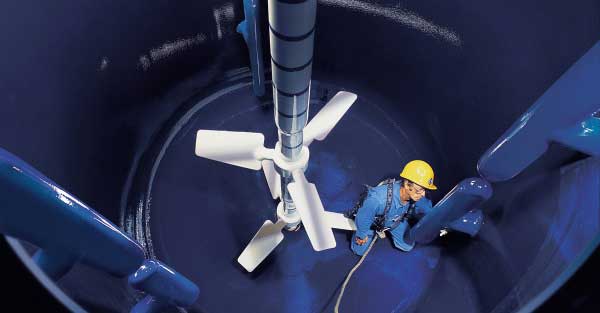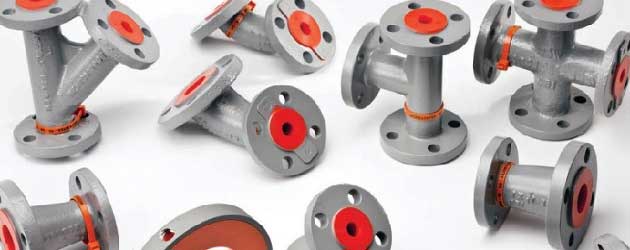Glass Lined Piping
If a process contains corrosive media, a lined pipe type can be chosen. The two main options are fluoropolymer-lined pipes (a term that refers to plastic materials such as PTFE) and glass-lined pipes.
The latter are manufactured using a similar process to glass-lined tanks and other glass-lined equipment.
The criteria below show that glass-clad pipes and fittings are a viable solution for process piping, providing safe protection from corrosive and hazardous media.
Properties of glass-lined pipes
Glass-lined pipes have the same properties and benefits as glass-lined vessels and other glass-lined components. These properties include..
- Flexibility - glass can handle a wide range of chemical conditions
- Purity - glass has high quality standards for food and drug applications
- Anti-sticking - many substances do not stick to glass, but do stick to metal
- Easy to clean - glass-coated surfaces can be cleaned and sterilized quickly and easily
- Absence of catalytic effect - the composition of glass eliminates the possible catalytic effect that can occur in vessels made of various exotic metals
- Corrosion resistance - glass is extremely resistant to corrosion by acids and alkalis (with the exception of hydrofluoric acid and hot concentrated phosphoric acid)
Performance of glass lined piping
Many plants have tested piping systems by installing different types under the same process conditions. While performance is similar in many respects, there is often greater variance over a longer period of time. Here are the areas where glass-lined pipes outperform other options when put to the test..

Construction: Unlike PTFE and other fluoropolymer lining materials that are soft and subject to abrasion and product build-up, glass is one of the hardest natural materials. Glass lining maintains its smooth, impervious surface, even in the harshest environments, to greatly reduce or in some cases eliminate product build-up.
Structural integrity: When it comes to adhesion between the lining and the base, glass wins hands down. Because the glass lining is made at extremely high temperatures, a mechanical and chemical/molecular bond is created. This bond is permanent, so the glass lining cannot separate from the base metal, making the design impervious to liner failure due to full vacuum conditions at high temperatures. With most other types of lining, only a mechanical connection to the base metal is made. Over time, the liner materials can become brittle or even shrink, which can cause them to separate from the base metal and cause the liner to collapse under vacuum.
Permeation: A major concern that arises in any application involving corrosive media is permeation, which must be carefully managed to prevent liner contamination or chemical attack on the steel substrate. Glass lining is not permeable and has no problem with chemicals that can permeate fluoropolymer piping. Chances are when considering glass-lined pipe, the process already includes e.g. a glass-lined reactor. If the construction material is satisfactory enough for the large, key units in the process, it is 100% certain that piping systems of the same manufacture will support the process requirements.
By assessing the performance of glass-lined piping in practical situations, it was found that they are particularly useful in the following applications..
- Abrasive slurries
- Fluids at high temperatures
- Sludge and foam piping systems
- Processes involving the transportation of acidic or alkaline liquids

Cost: It's no surprise that lined pipe is more expensive than unlined pipe, because a lot of extra work goes into production. If the process can function adequately with a more basic piping system, then an unlined pipe is the right choice. Glass-lined pipe is intended for processes that have more stringent requirements for corrosion resistance and cleanliness. Compared to the less expensive option of unlined pipe, the additional cost of glass lining is often offset by the reduction in man-hours required to clean piping systems.
Other considerations: Because lined piping is made from a metal as its base, the arrangement of the piping system must be carefully measured because the material is rigid and not deformable. However, PTFE pipes are somewhat versatile because pipe lengths can be shortened to the desired size and reconnected to fit the pipeline. Glass-lined pipe sections do not offer this kind of flexibility; because glass-lined equipment must be processed through a furnace, the length cannot be adjusted.
It is important to obtain accurate dimensions before ordering a pipe, a fitting or other composition. In some cases, spacers can be used to compensate for differences, but if a non-standard length is required, it must be made to order.
References.. glasslined-equip.com | www.gmmpfaudler.com | www.ddpsinc.com
Codes and Standards
DIN 2873 - PN 10 and PN 25 flanged enamelled steel pipes and fittings.
DIN EN ISO 28721-1 - Vitreous and porcelain enamels - Determination of resistance to chemical corrosion - Part 1: Determination of resistance to chemical corrosion by acids at room temperature (ISO 28706-1:2008).
DIN EN ISO 28721-2 - Vitreous and porcelain enamels - Determination of resistance to chemical corrosion - Part 2: Determination of resistance to chemical corrosion by boiling acids, boiling neutral liquids, alkaline liquids and/or their vapours (ISO 28706-2:2017).
DIN EN ISO 28721-3 - Vitreous and porcelain enamels - Determination of resistance to chemical corrosion - Part 3: Determination of resistance to chemical corrosion by alkaline liquids using a hexagonal vessel or a tetragonal glass bottle (ISO 28706-3:2017).
DIN EN ISO 28721-4 - Vitreous and porcelain enamels - Determination of resistance to chemical corrosion - Part 4: Determination of resistance to chemical corrosion by alkaline liquids using a cylindrical vessel (ISO 28706-4:2016).
DIN EN ISO 28721-5 - Vitreous and porcelain enamels - Determination of resistance to chemical corrosion - Part 5: Determination of resistance to chemical corrosion in closed systems (ISO 28706-5:2010).
Related Post(s)

To prevent corrosion e.g. in a pipe system, internal PTFE lining can be applied to steel pipes, elbows, tees, reducers, spacers, valves and other fittings installed in a pipeline...